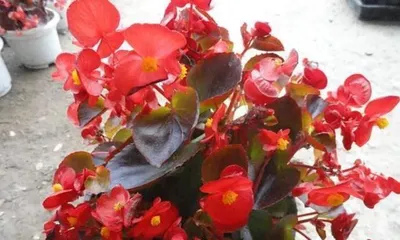Begonia semperflorens, commonly known as 'rose', is a common ornamental plant. Its vibrant colors and beautiful flower shapes are deeply loved by people. However, many people have some questions about the toxicity and suitable care environment of Begonia semperflorens. This article will provide a detailed introduction to the toxicity, suitable care environment, etc., to help readers better understand this plant and avoid unnecessary harm.

I. The Toxicity of Begonia semperflorens Cannot Be Ignored
Begonia semperflorens is a toxic plant, and its stems, leaves, flowers, and even fruits contain toxins. These toxins are mainly triterpenoid saponins, which have a strong irritant effect. If ingested or contacted, Begonia semperflorens can cause stinging and burning sensations in the mouth, throat, stomach, and other parts of the body. In severe cases, it can also cause symptoms such as vomiting, diarrhea, and poisoning. When caring for Begonia semperflorens, it is important to avoid ingestion or contact.
II. The Toxicity of Begonia semperflorens is Related to the Variety
Although Begonia semperflorens is a toxic plant, its toxicity varies by variety. Some varieties have relatively low toxicity and will not cause significant harm to the human body. For example, varieties like "Panchun" and "Panqiu" have relatively low toxicity. However, some varieties have relatively high toxicity, such as "Baiyuulan" and "Shanhua". When choosing Begonia semperflorens varieties, pay attention to the toxicity issue.

III. The Care Environment for Begonia semperflorens
Caring for Begonia semperflorens requires attention to the environment. Begonia semperflorens prefers a well-lit, well-ventilated environment, but cannot be exposed to direct sunlight. Begonia semperflorens likes a humid environment, but it should not be too humid, otherwise it is easy to cause pests and diseases. Pay attention to the appropriate temperature and air humidity. In high summer temperatures, maintain air humidity to prevent Begonia semperflorens from being damaged by excessive transpiration.
IV. The Care Soil for Begonia semperflorens
The care soil for Begonia semperflorens needs to be loose, breathable, and well-draining. It can be prepared using various materials such as leaf mold, peat soil, and perlite. At the same time, pay attention to controlling the soil's pH level. Begonia semperflorens prefers acidic soil, so acidic organic fertilizers can be added for adjustment.
V. The Watering Problem for Begonia semperflorens
The watering of Begonia semperflorens also needs attention. In general, the soil needs to be kept moist, but not overly wet. In high summer temperatures, pay attention to increasing the amount of watering to maintain air humidity. During winter care, control the amount of watering to avoid the soil becoming too moist.

VI. The Fertilization Problem for Begonia semperflorens
The fertilization of Begonia semperflorens also needs attention. In general, you can choose conventional compound fertilizer for application. In spring and summer, you can add appropriate amounts of nitrogen, phosphorus, and potassium compound fertilizers such as diammonium phosphate to promote plant growth and flowering. But be careful not to over-fertilize to avoid causing nutrient excess in the plant.
VII. The Propagation Methods for Begonia semperflorens
The propagation methods for Begonia semperflorens mainly include seed propagation, cutting propagation, and division propagation. Among them, seed propagation requires selecting mature fruits for planting and controlling temperature and humidity. Cutting propagation requires selecting vigorous branches for cutting, and controlling water and temperature. Division propagation requires selecting healthy plants for division, and paying attention to controlling water and soil humidity.
VIII. Common Pests and Diseases of Begonia semperflorens and Their Control Methods
The common pests and diseases of Begonia semperflorens mainly include leaf spot, gray mold, aphids, etc. For leaf spot and gray mold, methods such as cutting off the affected parts and ensuring ventilation can be used for control. For pests like aphids, insecticides can be sprayed. However, pay attention to the dosage and frequency of insecticides to avoid harming the plant.
IX. Pruning for Beauty of Begonia semperflorens
Pruning for beauty is also an important part of the care process. You can control the plant's shape and flowering quantity through pruning. In general, pruning is done in spring and summer, removing withered, diseased, and pest-infested parts, and controlling the number and position of flower buds to promote plant growth and flowering.
X. Suitable Places for Begonia semperflorens
Begonia semperflorens can be grown indoors and outdoors. For indoor care, it is important to choose a place with good ventilation, sufficient light, suitable temperature, and controlled air humidity. For outdoor care, pay attention to factors such as sunlight duration, water, and temperature to ensure the normal growth of the plant.
XI. Ornamental Effect of Begonia semperflorens
The ornamental effect of Begonia semperflorens is very good. Its vibrant colors and beautiful flower shapes are deeply loved by people. In spring and autumn, Begonia semperflorens will produce a large number of flowers, bringing people a pleasant visual enjoyment. It has also become an indispensable ornamental plant in many people's homes.
XII. Cultural Symbolism of Begonia semperflorens
Begonia semperflorens not only has ornamental value but also cultural symbolism. In Chinese culture, Begonia semperflorens is a symbol of elegance, beauty, and purity. It is also regarded as a symbol of family love and romance, representing people's yearning for and pursuit of a better life and happy family.
XIII. Regional Adaptability of Begonia semperflorens
Begonia semperflorens has strong adaptability and can grow in most parts of our country. It prefers a warm and humid climate and is highly adaptable to temperature and soil humidity. However, in the cold northern regions, the growth of Begonia semperflorens needs to pay attention to insulation and cold protection.
XIV. The Relationship Between Begonia semperflorens and Humans
Begonia semperflorens has a close relationship with humans. It is not only an important ornamental plant but can also be used for medicinal and edible purposes. Begonia semperflorens contains various chemical components that can be used to treat diseases such as colds and indigestion. In addition, the fruits of Begonia semperflorens can also be used to make foods such as jams and preserves.
XV.
Begonia semperflorens is a very important ornamental plant. When caring for Begonia semperflorens, it is necessary to pay attention to its toxicity, suitable care environment, care soil, watering and fertilizing, propagation methods, pruning for beauty, etc. Only by understanding these issues can we better care for Begonia semperflorens and make it a beautiful part of our lives.